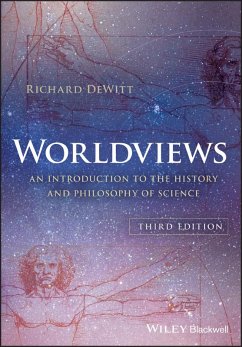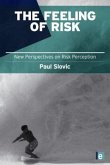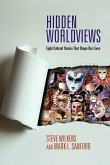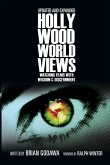Richard DeWitt (Fairfield University)
Worldviews
An Introduction to the History and Philosophy of Science
Richard DeWitt (Fairfield University)
Worldviews
An Introduction to the History and Philosophy of Science
- Broschiertes Buch
- Merkliste
- Auf die Merkliste
- Bewerten Bewerten
- Teilen
- Produkt teilen
- Produkterinnerung
- Produkterinnerung
PRAISE FOR PREVIOUS EDITIONS "This is a brilliantly clear introduction (and indeed reframing) of the history and philosophy of science in terms of worldviews and their elements.... In addition, the book is incredibly well-informed from both a scientific and philosophical angle. Highly recommended." --Scientific and Medical Network "Unlike many other introductions to philosophy of science, DeWitt's book is at once historically informative and philosophically thorough and rigorous. Chapter notes, suggested readings, and references enhance its value." --Choice "Written in clear and comprehensible…mehr
Andere Kunden interessierten sich auch für
![Transforming Worldviews - An Anthropological Understanding of How People Change Transforming Worldviews - An Anthropological Understanding of How People Change]() Paul G. HiebertTransforming Worldviews - An Anthropological Understanding of How People Change29,99 €
Paul G. HiebertTransforming Worldviews - An Anthropological Understanding of How People Change29,99 €![In Conversation with Karen Barad In Conversation with Karen Barad]() In Conversation with Karen Barad35,99 €
In Conversation with Karen Barad35,99 €![Creating Worldviews Creating Worldviews]() James W. UnderhillCreating Worldviews45,99 €
James W. UnderhillCreating Worldviews45,99 €![What Are Religions and Worldviews? What Are Religions and Worldviews?]() Deborah LockWhat Are Religions and Worldviews?13,99 €
Deborah LockWhat Are Religions and Worldviews?13,99 €![The Feeling of Risk The Feeling of Risk]() Paul Slovic (USA University of Oregon)The Feeling of Risk78,99 €
Paul Slovic (USA University of Oregon)The Feeling of Risk78,99 €![Hidden Worldviews Hidden Worldviews]() Steve WilkensHidden Worldviews29,99 €
Steve WilkensHidden Worldviews29,99 €![Hollywood Worldviews Hollywood Worldviews]() Brian GodawaHollywood Worldviews27,99 €
Brian GodawaHollywood Worldviews27,99 €-
-
-
PRAISE FOR PREVIOUS EDITIONS "This is a brilliantly clear introduction (and indeed reframing) of the history and philosophy of science in terms of worldviews and their elements.... In addition, the book is incredibly well-informed from both a scientific and philosophical angle. Highly recommended." --Scientific and Medical Network "Unlike many other introductions to philosophy of science, DeWitt's book is at once historically informative and philosophically thorough and rigorous. Chapter notes, suggested readings, and references enhance its value." --Choice "Written in clear and comprehensible prose and supplemented by effective diagrams and examples, Worldviews is an ideal text for anyone new to the history and philosophy of science. As the reader will come to find out, DeWitt is a gifted writer with the unique ability to break down complex and technical concepts into digestible parts, making Worldviews a welcoming and not overwhelming book for the introductory reader." --History and Philosophy of the Life Sciences, vol. 28(2) Now in its third edition, Worldviews: An Introduction to the History and Philosophy of Science strengthens its reputation as the most accessible and teachable introduction to the history and philosophy of science on the market. Geared toward engaging undergraduates and those approaching the history and philosophy of science for the first time, this intellectually-provocative volume takes advantage of its author's extensive teaching experience, parsing complex ideas using straightforward and sensible examples drawn from the physical sciences. Building on the foundations which earned the book its critical acclaim, author Richard DeWitt considers fundamental issues in the philosophy of science through the historical worldviews that influenced them, charting the evolution of Western science through the rise and fall of dominant systems of thought. Chapters have been updated to include discussion of recent findings in quantum theory, general relativity, and evolutionary theory, and two new chapters exclusive to the third edition enrich its engagement with radical developments in contemporary science. At a time in modern history when the nature of truth, fact, and reality seem increasingly controversial, the third edition of Worldviews presents complex concepts with clarity and verve, and prepares inquisitive minds to engage critically with some of the most exciting questions in the philosophy of science.
Hinweis: Dieser Artikel kann nur an eine deutsche Lieferadresse ausgeliefert werden.
Hinweis: Dieser Artikel kann nur an eine deutsche Lieferadresse ausgeliefert werden.
Produktdetails
- Produktdetails
- Verlag: John Wiley and Sons Ltd
- 3 ed
- Seitenzahl: 384
- Erscheinungstermin: 11. Mai 2018
- Englisch
- Abmessung: 241mm x 169mm x 25mm
- Gewicht: 672g
- ISBN-13: 9781119118893
- ISBN-10: 1119118891
- Artikelnr.: 49778007
- Herstellerkennzeichnung
- Libri GmbH
- Europaallee 1
- 36244 Bad Hersfeld
- 06621 890
- Verlag: John Wiley and Sons Ltd
- 3 ed
- Seitenzahl: 384
- Erscheinungstermin: 11. Mai 2018
- Englisch
- Abmessung: 241mm x 169mm x 25mm
- Gewicht: 672g
- ISBN-13: 9781119118893
- ISBN-10: 1119118891
- Artikelnr.: 49778007
- Herstellerkennzeichnung
- Libri GmbH
- Europaallee 1
- 36244 Bad Hersfeld
- 06621 890
Richard DeWitt is Professor of Philosophy at Fairfield University. His research interests are in the areas of mathematical and philosophical logic and the philosophy of mind. Recent publications include work with infinite valued logics in the Journal of Philosophical Logic and medieval logic in the International Philosophical Quarterly.
List of Figures xv
Acknowledgments xix
Introduction 1
Part I: Fundamental Issues 5
1 Worldviews 7
Aristotle's Beliefs and the Aristotelian Worldview 7
Aristotle's beliefs 8
The Aristotelian worldview 12
The Newtonian Worldview 12
Concluding Remarks 13
Evidence 13
Common sense 14
2 Truth 17
Preliminary Issues 17
Clarifying the Question 18
Correspondence Theories of Truth 19
Coherence Theories of Truth 20
Different versions of coherence theories 20
Problems/Puzzles about Correspondence Theories of Truth 22
Assessing the accuracy of representations 23
The Total Recall scenario 24
A word of caution 26
Problems/Puzzles for Coherence Theories of Truth 26
Philosophical Reflections: Descartes and the Cogito 28
Concluding Remarks 29
3 Empirical Facts and Philosophical/Conceptual Facts 31
Preliminary Observations 31
A Note on Terminology 34
Concluding Remarks 34
4 Confirming and Disconfirming Evidence and Reasoning 36
Confirmation Reasoning 36
Disconfirmation Reasoning 37
Inductive and Deductive Reasoning 37
Concluding Remarks 42
5 The Quine-Duhem Thesis and Implications for Scientific Method 43
The Quine-Duhem Thesis 43
Bodies of beliefs and the tribunal of experience 44
Crucial experiments 45
The underdetermination of theories 46
Implications for Scientific Method 47
Aristotle's axiomatic approach 48
Descartes' axiomatic approach 51
Popper's falsificationism 51
The hypothetico-deductive method 52
Concluding Remarks 53
6 A Philosophical Interlude: Problems and Puzzles of Induction 54
Hume's Problem of Induction 54
Hempel's Raven Paradox 57
Goodman's Gruesome Problem 59
Concluding Remarks 60
7 Falsifiability 61
Basic Ideas 61
Complicating Factors 62
Concluding Remarks 64
8 Instrumentalism and Realism 66
Prediction and Explanation 66
Instrumentalism and Realism 67
Concluding Remarks 70
Part II: The Transition from the Aristotelian Worldview to the Newtonian
Worldview 73
9 The Structure of the Universe on the Aristotelian Worldview 75
The Physical Structure of the Universe 75
Conceptual Beliefs about the Universe 77
Concluding Remarks 80
10 The Preface to Ptolemy's Almagest: The Earth as Spherical, Stationary,
and at the Center of the Universe 81
The Earth as Spherical 82
The Earth as Stationary 84
Common-sense arguments 84
The argument from objects in motion 86
The argument from stellar parallax 88
The Earth as the Center of the Universe 90
Concluding Remarks 91
11 Astronomical Data: The Empirical Facts 92
The Movement of the Stars 93
The Movement of the Sun 94
The Movement of the Moon 95
The Movement of the Planets 95
Concluding Remarks 98
12 Astronomical Data: The Philosophical/Conceptual Facts 99
A Scientific Problem with the Motion of the Heavenly Bodies 99
Three cautionary notes 102
Could This Account Be Used for a Moving Earth? 103
Concluding Remarks 104
13 The Ptolemaic System 106
Background Information 106
A Brief Description of the Components of Ptolemy's Treatment of Mars 107
The Rationale behind These Components 108
Concluding Remarks 114
14 The Copernican System 115
Background Information 115
Overview of the Copernican System 116
Comparison of the Ptolemaic and Copernican Systems 117
Respecting the facts 117
Complexity 118
Retrograde motion and other more "natural" explanations 118
From a realist standpoint, which system is the more plausible model of the
universe? 120
What Motivated Copernicus? 121
Neoplatonism 121
Copernicus' commitment to uniform, circular movement 122
The Reception of the Copernican Theory 123
Concluding Remarks 124
15 The Tychonic System 125
16 Kepler's System 128
Background Information 128
Tycho Brahe's empirical observations 128
Tycho and Kepler 129
Kepler's System 130
What Motivated Kepler? 131
Kepler's desire to read the mind of God 132
Concluding Remarks 136
17 Galileo and the Evidence from the Telescope 138
Background Information 138
Galileo and the Catholic church 138
A note on the nature of the evidence from the telescope 139
Galileo's Evidence from the Telescope 141
Mountains on the moon 141
Sunspots 142
The rings, or "ears," of Saturn 142
The moons of Jupiter 143
The phases of Venus 144
The stars 148
The Reception of Galileo's Discoveries 148
Falsifiability issues 149
Concluding Remarks 152
18 A Summary of Problems Facing the Aristotelian Worldview 154
Problems for the Aristotelian Worldview 154
The Need for a New Science 157
Concluding Remarks 157
A word of caution 158
19 Philosophical and Conceptual Connections in the Development of the New
Science 159
The Size of the Universe 159
Concluding Remarks 162
20 Overview of the New Science and the Newtonian Worldview 164
The New Science 164
The three laws of motion 165
Universal gravitation 165
Overview of the Newtonian Worldview 166
Philosophical Reflections: Instrumentalist and Realist Attitudes Toward
Newton's Concept of Gravity 168
Concluding Remarks 170
21 Philosophical Interlude: What Is a Scientific Law? 171
Scientific Laws 171
Common features associated with scientific laws 172
Exceptionless regularities 174
Counterfactuals 174
Context dependence 176
Ceteris paribus clauses 177
Concluding Remarks 178
22 The Development of the Newtonian Worldview, 1700-1900 179
Remarks on the Development of the Major Branches of Science, 1700-1900 179
Chemistry 180
Biology 181
Electromagnetic theory 182
General comments 184
Minor Clouds 184
The Michelson-Morley experiment 184
Black body radiation 187
Other issues 188
Concluding Remarks 190
Part III: Recent Developments In Science and Worldviews 191
23 The Special Theory of Relativity 193
Absolute Space and Absolute Time 193
Overview of the Special Theory of Relativity 195
The Irresistible Why Question 201
Is Special Relativity Self-Contradictory? 201
What about their disagreements on what the other clocks read? 204
From Joe's point of view 205
From Sara's point of view 205
Spacetime, Invariants, and the Geometrical Approach to Relativity 206
Concluding Remarks 210
24 The General Theory of Relativity 211
Basic Principles 211
The Einstein Field Equations and Predictions of General Relativity 213
Philosophical Reflections: General Relativity and Gravity 217
Concluding Remarks 218
25 Philosophical Interlude: Are (Some) Scientific Theories Incommensurable?
219
Preliminary Considerations 219
Exploring Incommensurability 221
Terminological incommensurability 222
Methodological incommensurability 224
Different worlds incommensurability 226
Discussion: Incommensurability and Scientific Progress 227
Concluding Remarks 229
26 Introduction to Quantum Theory: Basic Empirical Facts and the
Mathematics of Quantum Theory 230
Facts, Theory, and Interpretation 230
The quantum facts 231
Quantum theory itself 231
Interpretations of quantum theory 232
Some Quantum Facts 232
A brief excursion into a reality issue 233
Four experiments 235
Overview of the Mathematics of Quantum Theory 239
Descriptive overview of the mathematics of quantum theory 239
If the mathematics of quantum theory is a familiar sort of wave
mathematics, why do we often hear that quantum theory is such an unusual
theory? 240
A somewhat more detailed, but still descriptive, overview of the
mathematics of quantum theory 242
The evolution of states over time 247
Concluding Remarks 247
27 The Reality Question: The Measurement Problem and Interpretations of
Quantum Theory 248
The Measurement Problem 248
What is a measurement? 248
The role of measurement in Newtonian science 250
The role of measurement in quantum theory 250
Schrödinger's cat 253
The Measurement Problem 255
Subjectivity vs. objectivity 255
Measurement contexts vs. nonmeasurement contexts 256
System vs. apparatus; macroscopic vs. microscopic levels 256
Universality 257
Concluding thoughts on the measurement problem 258
Interpretations of Quantum Theory 258
Collapse interpretations 259
Mild measurement-dependent reality 261
Moderate measurement-dependent reality 262
Radical measurement-dependent reality (consciousness-dependent reality) 262
Non-collapse interpretations 263
Einstein's realism 263
Bohm's realism 265
The many-worlds interpretation 267
Observations on the interpretations of quantum theory 268
Concluding Remarks 271
28 Quantum Theory and Locality: EPR, Bell's Theorem, and the Aspect
Experiments 272
Background Information 272
The EPR Thought Experiment 273
The argument for (1) 275
Bell's Theorem 276
Aspect's Experiments 280
Locality, Nonlocality, and Spooky Action at a Distance 281
Concluding Remarks 285
29 Overview of the Theory of Evolution 286
Overview of the Basics of Evolutionary Theory 286
Darwin's and Wallace's discovery: Evolution by natural selection 286
A brief overview of evolutionary theory since Darwin and Wallace 288
A word of caution 292
Darwin's and Wallace's Paths to Natural Selection 293
The development of Darwin's views 293
The development of Wallace's views 296
Darwin's On the Origin of Species 297
The reception of the Origin of Species 299
Concluding Remarks 299
30 Reflections on Evolution 300
Implications for Religion 300
Dennett, Dawkins, Weinberg, and others: "no" 301
Haught, process philosophy, and process theology 302
Discussion 305
Morality and Ethics 307
Empirical Studies 310
The iterated prisoner's dilemma 310
The ultimatum game 313
Additional notes on cooperation and altruism 315
The trust game 316
Concluding Remarks 318
31 Worldviews: Concluding Thoughts 320
Overview 320
Reflections on Relativity Theory 322
Reflections on Quantum Theory 324
Reflections on Evolutionary Theory 325
Metaphors 326
Chapter Notes and Suggested Reading 329
References 349
Index 357
Acknowledgments xix
Introduction 1
Part I: Fundamental Issues 5
1 Worldviews 7
Aristotle's Beliefs and the Aristotelian Worldview 7
Aristotle's beliefs 8
The Aristotelian worldview 12
The Newtonian Worldview 12
Concluding Remarks 13
Evidence 13
Common sense 14
2 Truth 17
Preliminary Issues 17
Clarifying the Question 18
Correspondence Theories of Truth 19
Coherence Theories of Truth 20
Different versions of coherence theories 20
Problems/Puzzles about Correspondence Theories of Truth 22
Assessing the accuracy of representations 23
The Total Recall scenario 24
A word of caution 26
Problems/Puzzles for Coherence Theories of Truth 26
Philosophical Reflections: Descartes and the Cogito 28
Concluding Remarks 29
3 Empirical Facts and Philosophical/Conceptual Facts 31
Preliminary Observations 31
A Note on Terminology 34
Concluding Remarks 34
4 Confirming and Disconfirming Evidence and Reasoning 36
Confirmation Reasoning 36
Disconfirmation Reasoning 37
Inductive and Deductive Reasoning 37
Concluding Remarks 42
5 The Quine-Duhem Thesis and Implications for Scientific Method 43
The Quine-Duhem Thesis 43
Bodies of beliefs and the tribunal of experience 44
Crucial experiments 45
The underdetermination of theories 46
Implications for Scientific Method 47
Aristotle's axiomatic approach 48
Descartes' axiomatic approach 51
Popper's falsificationism 51
The hypothetico-deductive method 52
Concluding Remarks 53
6 A Philosophical Interlude: Problems and Puzzles of Induction 54
Hume's Problem of Induction 54
Hempel's Raven Paradox 57
Goodman's Gruesome Problem 59
Concluding Remarks 60
7 Falsifiability 61
Basic Ideas 61
Complicating Factors 62
Concluding Remarks 64
8 Instrumentalism and Realism 66
Prediction and Explanation 66
Instrumentalism and Realism 67
Concluding Remarks 70
Part II: The Transition from the Aristotelian Worldview to the Newtonian
Worldview 73
9 The Structure of the Universe on the Aristotelian Worldview 75
The Physical Structure of the Universe 75
Conceptual Beliefs about the Universe 77
Concluding Remarks 80
10 The Preface to Ptolemy's Almagest: The Earth as Spherical, Stationary,
and at the Center of the Universe 81
The Earth as Spherical 82
The Earth as Stationary 84
Common-sense arguments 84
The argument from objects in motion 86
The argument from stellar parallax 88
The Earth as the Center of the Universe 90
Concluding Remarks 91
11 Astronomical Data: The Empirical Facts 92
The Movement of the Stars 93
The Movement of the Sun 94
The Movement of the Moon 95
The Movement of the Planets 95
Concluding Remarks 98
12 Astronomical Data: The Philosophical/Conceptual Facts 99
A Scientific Problem with the Motion of the Heavenly Bodies 99
Three cautionary notes 102
Could This Account Be Used for a Moving Earth? 103
Concluding Remarks 104
13 The Ptolemaic System 106
Background Information 106
A Brief Description of the Components of Ptolemy's Treatment of Mars 107
The Rationale behind These Components 108
Concluding Remarks 114
14 The Copernican System 115
Background Information 115
Overview of the Copernican System 116
Comparison of the Ptolemaic and Copernican Systems 117
Respecting the facts 117
Complexity 118
Retrograde motion and other more "natural" explanations 118
From a realist standpoint, which system is the more plausible model of the
universe? 120
What Motivated Copernicus? 121
Neoplatonism 121
Copernicus' commitment to uniform, circular movement 122
The Reception of the Copernican Theory 123
Concluding Remarks 124
15 The Tychonic System 125
16 Kepler's System 128
Background Information 128
Tycho Brahe's empirical observations 128
Tycho and Kepler 129
Kepler's System 130
What Motivated Kepler? 131
Kepler's desire to read the mind of God 132
Concluding Remarks 136
17 Galileo and the Evidence from the Telescope 138
Background Information 138
Galileo and the Catholic church 138
A note on the nature of the evidence from the telescope 139
Galileo's Evidence from the Telescope 141
Mountains on the moon 141
Sunspots 142
The rings, or "ears," of Saturn 142
The moons of Jupiter 143
The phases of Venus 144
The stars 148
The Reception of Galileo's Discoveries 148
Falsifiability issues 149
Concluding Remarks 152
18 A Summary of Problems Facing the Aristotelian Worldview 154
Problems for the Aristotelian Worldview 154
The Need for a New Science 157
Concluding Remarks 157
A word of caution 158
19 Philosophical and Conceptual Connections in the Development of the New
Science 159
The Size of the Universe 159
Concluding Remarks 162
20 Overview of the New Science and the Newtonian Worldview 164
The New Science 164
The three laws of motion 165
Universal gravitation 165
Overview of the Newtonian Worldview 166
Philosophical Reflections: Instrumentalist and Realist Attitudes Toward
Newton's Concept of Gravity 168
Concluding Remarks 170
21 Philosophical Interlude: What Is a Scientific Law? 171
Scientific Laws 171
Common features associated with scientific laws 172
Exceptionless regularities 174
Counterfactuals 174
Context dependence 176
Ceteris paribus clauses 177
Concluding Remarks 178
22 The Development of the Newtonian Worldview, 1700-1900 179
Remarks on the Development of the Major Branches of Science, 1700-1900 179
Chemistry 180
Biology 181
Electromagnetic theory 182
General comments 184
Minor Clouds 184
The Michelson-Morley experiment 184
Black body radiation 187
Other issues 188
Concluding Remarks 190
Part III: Recent Developments In Science and Worldviews 191
23 The Special Theory of Relativity 193
Absolute Space and Absolute Time 193
Overview of the Special Theory of Relativity 195
The Irresistible Why Question 201
Is Special Relativity Self-Contradictory? 201
What about their disagreements on what the other clocks read? 204
From Joe's point of view 205
From Sara's point of view 205
Spacetime, Invariants, and the Geometrical Approach to Relativity 206
Concluding Remarks 210
24 The General Theory of Relativity 211
Basic Principles 211
The Einstein Field Equations and Predictions of General Relativity 213
Philosophical Reflections: General Relativity and Gravity 217
Concluding Remarks 218
25 Philosophical Interlude: Are (Some) Scientific Theories Incommensurable?
219
Preliminary Considerations 219
Exploring Incommensurability 221
Terminological incommensurability 222
Methodological incommensurability 224
Different worlds incommensurability 226
Discussion: Incommensurability and Scientific Progress 227
Concluding Remarks 229
26 Introduction to Quantum Theory: Basic Empirical Facts and the
Mathematics of Quantum Theory 230
Facts, Theory, and Interpretation 230
The quantum facts 231
Quantum theory itself 231
Interpretations of quantum theory 232
Some Quantum Facts 232
A brief excursion into a reality issue 233
Four experiments 235
Overview of the Mathematics of Quantum Theory 239
Descriptive overview of the mathematics of quantum theory 239
If the mathematics of quantum theory is a familiar sort of wave
mathematics, why do we often hear that quantum theory is such an unusual
theory? 240
A somewhat more detailed, but still descriptive, overview of the
mathematics of quantum theory 242
The evolution of states over time 247
Concluding Remarks 247
27 The Reality Question: The Measurement Problem and Interpretations of
Quantum Theory 248
The Measurement Problem 248
What is a measurement? 248
The role of measurement in Newtonian science 250
The role of measurement in quantum theory 250
Schrödinger's cat 253
The Measurement Problem 255
Subjectivity vs. objectivity 255
Measurement contexts vs. nonmeasurement contexts 256
System vs. apparatus; macroscopic vs. microscopic levels 256
Universality 257
Concluding thoughts on the measurement problem 258
Interpretations of Quantum Theory 258
Collapse interpretations 259
Mild measurement-dependent reality 261
Moderate measurement-dependent reality 262
Radical measurement-dependent reality (consciousness-dependent reality) 262
Non-collapse interpretations 263
Einstein's realism 263
Bohm's realism 265
The many-worlds interpretation 267
Observations on the interpretations of quantum theory 268
Concluding Remarks 271
28 Quantum Theory and Locality: EPR, Bell's Theorem, and the Aspect
Experiments 272
Background Information 272
The EPR Thought Experiment 273
The argument for (1) 275
Bell's Theorem 276
Aspect's Experiments 280
Locality, Nonlocality, and Spooky Action at a Distance 281
Concluding Remarks 285
29 Overview of the Theory of Evolution 286
Overview of the Basics of Evolutionary Theory 286
Darwin's and Wallace's discovery: Evolution by natural selection 286
A brief overview of evolutionary theory since Darwin and Wallace 288
A word of caution 292
Darwin's and Wallace's Paths to Natural Selection 293
The development of Darwin's views 293
The development of Wallace's views 296
Darwin's On the Origin of Species 297
The reception of the Origin of Species 299
Concluding Remarks 299
30 Reflections on Evolution 300
Implications for Religion 300
Dennett, Dawkins, Weinberg, and others: "no" 301
Haught, process philosophy, and process theology 302
Discussion 305
Morality and Ethics 307
Empirical Studies 310
The iterated prisoner's dilemma 310
The ultimatum game 313
Additional notes on cooperation and altruism 315
The trust game 316
Concluding Remarks 318
31 Worldviews: Concluding Thoughts 320
Overview 320
Reflections on Relativity Theory 322
Reflections on Quantum Theory 324
Reflections on Evolutionary Theory 325
Metaphors 326
Chapter Notes and Suggested Reading 329
References 349
Index 357
List of Figures xv
Acknowledgments xix
Introduction 1
Part I: Fundamental Issues 5
1 Worldviews 7
Aristotle's Beliefs and the Aristotelian Worldview 7
Aristotle's beliefs 8
The Aristotelian worldview 12
The Newtonian Worldview 12
Concluding Remarks 13
Evidence 13
Common sense 14
2 Truth 17
Preliminary Issues 17
Clarifying the Question 18
Correspondence Theories of Truth 19
Coherence Theories of Truth 20
Different versions of coherence theories 20
Problems/Puzzles about Correspondence Theories of Truth 22
Assessing the accuracy of representations 23
The Total Recall scenario 24
A word of caution 26
Problems/Puzzles for Coherence Theories of Truth 26
Philosophical Reflections: Descartes and the Cogito 28
Concluding Remarks 29
3 Empirical Facts and Philosophical/Conceptual Facts 31
Preliminary Observations 31
A Note on Terminology 34
Concluding Remarks 34
4 Confirming and Disconfirming Evidence and Reasoning 36
Confirmation Reasoning 36
Disconfirmation Reasoning 37
Inductive and Deductive Reasoning 37
Concluding Remarks 42
5 The Quine-Duhem Thesis and Implications for Scientific Method 43
The Quine-Duhem Thesis 43
Bodies of beliefs and the tribunal of experience 44
Crucial experiments 45
The underdetermination of theories 46
Implications for Scientific Method 47
Aristotle's axiomatic approach 48
Descartes' axiomatic approach 51
Popper's falsificationism 51
The hypothetico-deductive method 52
Concluding Remarks 53
6 A Philosophical Interlude: Problems and Puzzles of Induction 54
Hume's Problem of Induction 54
Hempel's Raven Paradox 57
Goodman's Gruesome Problem 59
Concluding Remarks 60
7 Falsifiability 61
Basic Ideas 61
Complicating Factors 62
Concluding Remarks 64
8 Instrumentalism and Realism 66
Prediction and Explanation 66
Instrumentalism and Realism 67
Concluding Remarks 70
Part II: The Transition from the Aristotelian Worldview to the Newtonian
Worldview 73
9 The Structure of the Universe on the Aristotelian Worldview 75
The Physical Structure of the Universe 75
Conceptual Beliefs about the Universe 77
Concluding Remarks 80
10 The Preface to Ptolemy's Almagest: The Earth as Spherical, Stationary,
and at the Center of the Universe 81
The Earth as Spherical 82
The Earth as Stationary 84
Common-sense arguments 84
The argument from objects in motion 86
The argument from stellar parallax 88
The Earth as the Center of the Universe 90
Concluding Remarks 91
11 Astronomical Data: The Empirical Facts 92
The Movement of the Stars 93
The Movement of the Sun 94
The Movement of the Moon 95
The Movement of the Planets 95
Concluding Remarks 98
12 Astronomical Data: The Philosophical/Conceptual Facts 99
A Scientific Problem with the Motion of the Heavenly Bodies 99
Three cautionary notes 102
Could This Account Be Used for a Moving Earth? 103
Concluding Remarks 104
13 The Ptolemaic System 106
Background Information 106
A Brief Description of the Components of Ptolemy's Treatment of Mars 107
The Rationale behind These Components 108
Concluding Remarks 114
14 The Copernican System 115
Background Information 115
Overview of the Copernican System 116
Comparison of the Ptolemaic and Copernican Systems 117
Respecting the facts 117
Complexity 118
Retrograde motion and other more "natural" explanations 118
From a realist standpoint, which system is the more plausible model of the
universe? 120
What Motivated Copernicus? 121
Neoplatonism 121
Copernicus' commitment to uniform, circular movement 122
The Reception of the Copernican Theory 123
Concluding Remarks 124
15 The Tychonic System 125
16 Kepler's System 128
Background Information 128
Tycho Brahe's empirical observations 128
Tycho and Kepler 129
Kepler's System 130
What Motivated Kepler? 131
Kepler's desire to read the mind of God 132
Concluding Remarks 136
17 Galileo and the Evidence from the Telescope 138
Background Information 138
Galileo and the Catholic church 138
A note on the nature of the evidence from the telescope 139
Galileo's Evidence from the Telescope 141
Mountains on the moon 141
Sunspots 142
The rings, or "ears," of Saturn 142
The moons of Jupiter 143
The phases of Venus 144
The stars 148
The Reception of Galileo's Discoveries 148
Falsifiability issues 149
Concluding Remarks 152
18 A Summary of Problems Facing the Aristotelian Worldview 154
Problems for the Aristotelian Worldview 154
The Need for a New Science 157
Concluding Remarks 157
A word of caution 158
19 Philosophical and Conceptual Connections in the Development of the New
Science 159
The Size of the Universe 159
Concluding Remarks 162
20 Overview of the New Science and the Newtonian Worldview 164
The New Science 164
The three laws of motion 165
Universal gravitation 165
Overview of the Newtonian Worldview 166
Philosophical Reflections: Instrumentalist and Realist Attitudes Toward
Newton's Concept of Gravity 168
Concluding Remarks 170
21 Philosophical Interlude: What Is a Scientific Law? 171
Scientific Laws 171
Common features associated with scientific laws 172
Exceptionless regularities 174
Counterfactuals 174
Context dependence 176
Ceteris paribus clauses 177
Concluding Remarks 178
22 The Development of the Newtonian Worldview, 1700-1900 179
Remarks on the Development of the Major Branches of Science, 1700-1900 179
Chemistry 180
Biology 181
Electromagnetic theory 182
General comments 184
Minor Clouds 184
The Michelson-Morley experiment 184
Black body radiation 187
Other issues 188
Concluding Remarks 190
Part III: Recent Developments In Science and Worldviews 191
23 The Special Theory of Relativity 193
Absolute Space and Absolute Time 193
Overview of the Special Theory of Relativity 195
The Irresistible Why Question 201
Is Special Relativity Self-Contradictory? 201
What about their disagreements on what the other clocks read? 204
From Joe's point of view 205
From Sara's point of view 205
Spacetime, Invariants, and the Geometrical Approach to Relativity 206
Concluding Remarks 210
24 The General Theory of Relativity 211
Basic Principles 211
The Einstein Field Equations and Predictions of General Relativity 213
Philosophical Reflections: General Relativity and Gravity 217
Concluding Remarks 218
25 Philosophical Interlude: Are (Some) Scientific Theories Incommensurable?
219
Preliminary Considerations 219
Exploring Incommensurability 221
Terminological incommensurability 222
Methodological incommensurability 224
Different worlds incommensurability 226
Discussion: Incommensurability and Scientific Progress 227
Concluding Remarks 229
26 Introduction to Quantum Theory: Basic Empirical Facts and the
Mathematics of Quantum Theory 230
Facts, Theory, and Interpretation 230
The quantum facts 231
Quantum theory itself 231
Interpretations of quantum theory 232
Some Quantum Facts 232
A brief excursion into a reality issue 233
Four experiments 235
Overview of the Mathematics of Quantum Theory 239
Descriptive overview of the mathematics of quantum theory 239
If the mathematics of quantum theory is a familiar sort of wave
mathematics, why do we often hear that quantum theory is such an unusual
theory? 240
A somewhat more detailed, but still descriptive, overview of the
mathematics of quantum theory 242
The evolution of states over time 247
Concluding Remarks 247
27 The Reality Question: The Measurement Problem and Interpretations of
Quantum Theory 248
The Measurement Problem 248
What is a measurement? 248
The role of measurement in Newtonian science 250
The role of measurement in quantum theory 250
Schrödinger's cat 253
The Measurement Problem 255
Subjectivity vs. objectivity 255
Measurement contexts vs. nonmeasurement contexts 256
System vs. apparatus; macroscopic vs. microscopic levels 256
Universality 257
Concluding thoughts on the measurement problem 258
Interpretations of Quantum Theory 258
Collapse interpretations 259
Mild measurement-dependent reality 261
Moderate measurement-dependent reality 262
Radical measurement-dependent reality (consciousness-dependent reality) 262
Non-collapse interpretations 263
Einstein's realism 263
Bohm's realism 265
The many-worlds interpretation 267
Observations on the interpretations of quantum theory 268
Concluding Remarks 271
28 Quantum Theory and Locality: EPR, Bell's Theorem, and the Aspect
Experiments 272
Background Information 272
The EPR Thought Experiment 273
The argument for (1) 275
Bell's Theorem 276
Aspect's Experiments 280
Locality, Nonlocality, and Spooky Action at a Distance 281
Concluding Remarks 285
29 Overview of the Theory of Evolution 286
Overview of the Basics of Evolutionary Theory 286
Darwin's and Wallace's discovery: Evolution by natural selection 286
A brief overview of evolutionary theory since Darwin and Wallace 288
A word of caution 292
Darwin's and Wallace's Paths to Natural Selection 293
The development of Darwin's views 293
The development of Wallace's views 296
Darwin's On the Origin of Species 297
The reception of the Origin of Species 299
Concluding Remarks 299
30 Reflections on Evolution 300
Implications for Religion 300
Dennett, Dawkins, Weinberg, and others: "no" 301
Haught, process philosophy, and process theology 302
Discussion 305
Morality and Ethics 307
Empirical Studies 310
The iterated prisoner's dilemma 310
The ultimatum game 313
Additional notes on cooperation and altruism 315
The trust game 316
Concluding Remarks 318
31 Worldviews: Concluding Thoughts 320
Overview 320
Reflections on Relativity Theory 322
Reflections on Quantum Theory 324
Reflections on Evolutionary Theory 325
Metaphors 326
Chapter Notes and Suggested Reading 329
References 349
Index 357
Acknowledgments xix
Introduction 1
Part I: Fundamental Issues 5
1 Worldviews 7
Aristotle's Beliefs and the Aristotelian Worldview 7
Aristotle's beliefs 8
The Aristotelian worldview 12
The Newtonian Worldview 12
Concluding Remarks 13
Evidence 13
Common sense 14
2 Truth 17
Preliminary Issues 17
Clarifying the Question 18
Correspondence Theories of Truth 19
Coherence Theories of Truth 20
Different versions of coherence theories 20
Problems/Puzzles about Correspondence Theories of Truth 22
Assessing the accuracy of representations 23
The Total Recall scenario 24
A word of caution 26
Problems/Puzzles for Coherence Theories of Truth 26
Philosophical Reflections: Descartes and the Cogito 28
Concluding Remarks 29
3 Empirical Facts and Philosophical/Conceptual Facts 31
Preliminary Observations 31
A Note on Terminology 34
Concluding Remarks 34
4 Confirming and Disconfirming Evidence and Reasoning 36
Confirmation Reasoning 36
Disconfirmation Reasoning 37
Inductive and Deductive Reasoning 37
Concluding Remarks 42
5 The Quine-Duhem Thesis and Implications for Scientific Method 43
The Quine-Duhem Thesis 43
Bodies of beliefs and the tribunal of experience 44
Crucial experiments 45
The underdetermination of theories 46
Implications for Scientific Method 47
Aristotle's axiomatic approach 48
Descartes' axiomatic approach 51
Popper's falsificationism 51
The hypothetico-deductive method 52
Concluding Remarks 53
6 A Philosophical Interlude: Problems and Puzzles of Induction 54
Hume's Problem of Induction 54
Hempel's Raven Paradox 57
Goodman's Gruesome Problem 59
Concluding Remarks 60
7 Falsifiability 61
Basic Ideas 61
Complicating Factors 62
Concluding Remarks 64
8 Instrumentalism and Realism 66
Prediction and Explanation 66
Instrumentalism and Realism 67
Concluding Remarks 70
Part II: The Transition from the Aristotelian Worldview to the Newtonian
Worldview 73
9 The Structure of the Universe on the Aristotelian Worldview 75
The Physical Structure of the Universe 75
Conceptual Beliefs about the Universe 77
Concluding Remarks 80
10 The Preface to Ptolemy's Almagest: The Earth as Spherical, Stationary,
and at the Center of the Universe 81
The Earth as Spherical 82
The Earth as Stationary 84
Common-sense arguments 84
The argument from objects in motion 86
The argument from stellar parallax 88
The Earth as the Center of the Universe 90
Concluding Remarks 91
11 Astronomical Data: The Empirical Facts 92
The Movement of the Stars 93
The Movement of the Sun 94
The Movement of the Moon 95
The Movement of the Planets 95
Concluding Remarks 98
12 Astronomical Data: The Philosophical/Conceptual Facts 99
A Scientific Problem with the Motion of the Heavenly Bodies 99
Three cautionary notes 102
Could This Account Be Used for a Moving Earth? 103
Concluding Remarks 104
13 The Ptolemaic System 106
Background Information 106
A Brief Description of the Components of Ptolemy's Treatment of Mars 107
The Rationale behind These Components 108
Concluding Remarks 114
14 The Copernican System 115
Background Information 115
Overview of the Copernican System 116
Comparison of the Ptolemaic and Copernican Systems 117
Respecting the facts 117
Complexity 118
Retrograde motion and other more "natural" explanations 118
From a realist standpoint, which system is the more plausible model of the
universe? 120
What Motivated Copernicus? 121
Neoplatonism 121
Copernicus' commitment to uniform, circular movement 122
The Reception of the Copernican Theory 123
Concluding Remarks 124
15 The Tychonic System 125
16 Kepler's System 128
Background Information 128
Tycho Brahe's empirical observations 128
Tycho and Kepler 129
Kepler's System 130
What Motivated Kepler? 131
Kepler's desire to read the mind of God 132
Concluding Remarks 136
17 Galileo and the Evidence from the Telescope 138
Background Information 138
Galileo and the Catholic church 138
A note on the nature of the evidence from the telescope 139
Galileo's Evidence from the Telescope 141
Mountains on the moon 141
Sunspots 142
The rings, or "ears," of Saturn 142
The moons of Jupiter 143
The phases of Venus 144
The stars 148
The Reception of Galileo's Discoveries 148
Falsifiability issues 149
Concluding Remarks 152
18 A Summary of Problems Facing the Aristotelian Worldview 154
Problems for the Aristotelian Worldview 154
The Need for a New Science 157
Concluding Remarks 157
A word of caution 158
19 Philosophical and Conceptual Connections in the Development of the New
Science 159
The Size of the Universe 159
Concluding Remarks 162
20 Overview of the New Science and the Newtonian Worldview 164
The New Science 164
The three laws of motion 165
Universal gravitation 165
Overview of the Newtonian Worldview 166
Philosophical Reflections: Instrumentalist and Realist Attitudes Toward
Newton's Concept of Gravity 168
Concluding Remarks 170
21 Philosophical Interlude: What Is a Scientific Law? 171
Scientific Laws 171
Common features associated with scientific laws 172
Exceptionless regularities 174
Counterfactuals 174
Context dependence 176
Ceteris paribus clauses 177
Concluding Remarks 178
22 The Development of the Newtonian Worldview, 1700-1900 179
Remarks on the Development of the Major Branches of Science, 1700-1900 179
Chemistry 180
Biology 181
Electromagnetic theory 182
General comments 184
Minor Clouds 184
The Michelson-Morley experiment 184
Black body radiation 187
Other issues 188
Concluding Remarks 190
Part III: Recent Developments In Science and Worldviews 191
23 The Special Theory of Relativity 193
Absolute Space and Absolute Time 193
Overview of the Special Theory of Relativity 195
The Irresistible Why Question 201
Is Special Relativity Self-Contradictory? 201
What about their disagreements on what the other clocks read? 204
From Joe's point of view 205
From Sara's point of view 205
Spacetime, Invariants, and the Geometrical Approach to Relativity 206
Concluding Remarks 210
24 The General Theory of Relativity 211
Basic Principles 211
The Einstein Field Equations and Predictions of General Relativity 213
Philosophical Reflections: General Relativity and Gravity 217
Concluding Remarks 218
25 Philosophical Interlude: Are (Some) Scientific Theories Incommensurable?
219
Preliminary Considerations 219
Exploring Incommensurability 221
Terminological incommensurability 222
Methodological incommensurability 224
Different worlds incommensurability 226
Discussion: Incommensurability and Scientific Progress 227
Concluding Remarks 229
26 Introduction to Quantum Theory: Basic Empirical Facts and the
Mathematics of Quantum Theory 230
Facts, Theory, and Interpretation 230
The quantum facts 231
Quantum theory itself 231
Interpretations of quantum theory 232
Some Quantum Facts 232
A brief excursion into a reality issue 233
Four experiments 235
Overview of the Mathematics of Quantum Theory 239
Descriptive overview of the mathematics of quantum theory 239
If the mathematics of quantum theory is a familiar sort of wave
mathematics, why do we often hear that quantum theory is such an unusual
theory? 240
A somewhat more detailed, but still descriptive, overview of the
mathematics of quantum theory 242
The evolution of states over time 247
Concluding Remarks 247
27 The Reality Question: The Measurement Problem and Interpretations of
Quantum Theory 248
The Measurement Problem 248
What is a measurement? 248
The role of measurement in Newtonian science 250
The role of measurement in quantum theory 250
Schrödinger's cat 253
The Measurement Problem 255
Subjectivity vs. objectivity 255
Measurement contexts vs. nonmeasurement contexts 256
System vs. apparatus; macroscopic vs. microscopic levels 256
Universality 257
Concluding thoughts on the measurement problem 258
Interpretations of Quantum Theory 258
Collapse interpretations 259
Mild measurement-dependent reality 261
Moderate measurement-dependent reality 262
Radical measurement-dependent reality (consciousness-dependent reality) 262
Non-collapse interpretations 263
Einstein's realism 263
Bohm's realism 265
The many-worlds interpretation 267
Observations on the interpretations of quantum theory 268
Concluding Remarks 271
28 Quantum Theory and Locality: EPR, Bell's Theorem, and the Aspect
Experiments 272
Background Information 272
The EPR Thought Experiment 273
The argument for (1) 275
Bell's Theorem 276
Aspect's Experiments 280
Locality, Nonlocality, and Spooky Action at a Distance 281
Concluding Remarks 285
29 Overview of the Theory of Evolution 286
Overview of the Basics of Evolutionary Theory 286
Darwin's and Wallace's discovery: Evolution by natural selection 286
A brief overview of evolutionary theory since Darwin and Wallace 288
A word of caution 292
Darwin's and Wallace's Paths to Natural Selection 293
The development of Darwin's views 293
The development of Wallace's views 296
Darwin's On the Origin of Species 297
The reception of the Origin of Species 299
Concluding Remarks 299
30 Reflections on Evolution 300
Implications for Religion 300
Dennett, Dawkins, Weinberg, and others: "no" 301
Haught, process philosophy, and process theology 302
Discussion 305
Morality and Ethics 307
Empirical Studies 310
The iterated prisoner's dilemma 310
The ultimatum game 313
Additional notes on cooperation and altruism 315
The trust game 316
Concluding Remarks 318
31 Worldviews: Concluding Thoughts 320
Overview 320
Reflections on Relativity Theory 322
Reflections on Quantum Theory 324
Reflections on Evolutionary Theory 325
Metaphors 326
Chapter Notes and Suggested Reading 329
References 349
Index 357








